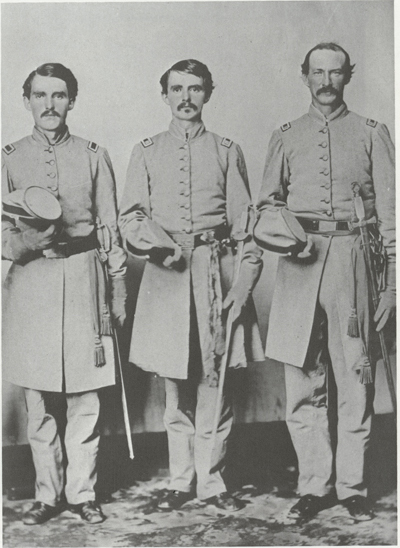Julian A. Latham, Louis C. Latham and
Nehemiah H. Whitehurst
(Washington County)
Featured Character – 1864 Confederate
Decline

Second
Lieutenant Julian A. Latham, Captain Louis C. Latham, First Lieutenant
Nehemiah H. Whitehurst
Courtesy of the Washington County
Historical Society
Born in 1843, Julian
Augustus Latham was the son of Washington
County politician Charles
Latham. A student at the University of North Carolina, Latham left college to
enlist in his brother’s “Washington Volunteers,” which entered Confederate
service as Company G of the First North Carolina Infantry. He was
wounded at Chancellorsville,
Virginia, on May 3, 1863, but
when he returned to active duty, he was subsequently promoted to 1st
lieutenant in December of that year. However, on May 10, 1864, Latham was
captured at Spotsylvania Court House in Virginia
and taken to the prison at Fort
Delaware. Three months
later, Latham was transferred to Hilton Head, South
Carolina and again to Fort Pulaski,
Georgia in October, back to
Hilton Head, and finally back to Fort
Delaware in March 1865.
He took the Oath of Allegiance and was released on June 16, 1865. Instead of returning to college, Latham
became a fisherman. He died in
1880. In 1911, the University of North
Carolina gave Latham a posthumous Bachelor of
Arts degree.
Born
on September 11, 1840, Louis
Charles Latham was the son of Washington County
politician Charles
Latham. He
graduated from the University
of North Carolina
in 1859, and then attended Harvard Law School. Although his father firmly
believed in the Union,
Louis C. Latham raised the “Washington Volunteers,”
which became Company G, 1st North Carolina
Infantry. Wounded
at the Battle of Antietam, Maryland, Latham
became the regiment’s major on December 14, 1863.
Shot in the left side at the Wilderness, Virginia,
in 1864, he
spent several months convalescing.
In
the fall of 1864, Washington County
voters elected
Latham as their state representative.
Taking leave from the army, he worked the halls of the
state capitol for
two months. However,
he returned to the army
in time to surrender at Appomattox
with Robert E. Lee. Returning
home,
Latham finished his law studies and opened a practice in Plymouth.
In 1870, he served one term in the state senate as a
Democrat. In 1880,
Latham ran for Congress. Elected
as a Democrat, he failed to win his
party’s nomination in 1882. In
1886 he
won another term, but lost his reelection bid to Republican Walter
Freshwater
Pool of Elizabeth City. After
his
defeat, Latham moved his law practice to Greenville, North Carolina. He died there on October
16, 1895.
Born
in Virginia in
1825, Nehemiah
J. Whitehurst worked as a carpenter in Norfolk
and Portsmouth,
Virginia.
In August 1860, he won the contract to build Grace
Episcopal Church in Plymouth, North
Carolina.
Whitehurst and his crew erected the building’s shell
before war broke
out, but a lack of materials hampered final construction. After the state’s
secession, Whitehurst
joined Louis C. Latham’s “Washington Volunteers,” later Company G, 1st
North Carolina Infantry. Appointed
first
lieutenant, he served with the unit in Virginia. After Latham became the
regimental major in
December 1863, Confederate officials promoted Whitehurst to captain. At the Battle of
Spotsylvania Courthouse,
Virginia, Union forces captured him.
Sent to Fort Delaware,
Whitehurst
spent the rest of the war as a prisoner of war.
After taking the Oath of Allegiance on June 16, 1865,
Federal
authorities released him. Whitehurst
returned to Plymouth,
married a local woman, and continued to work as a carpenter.
